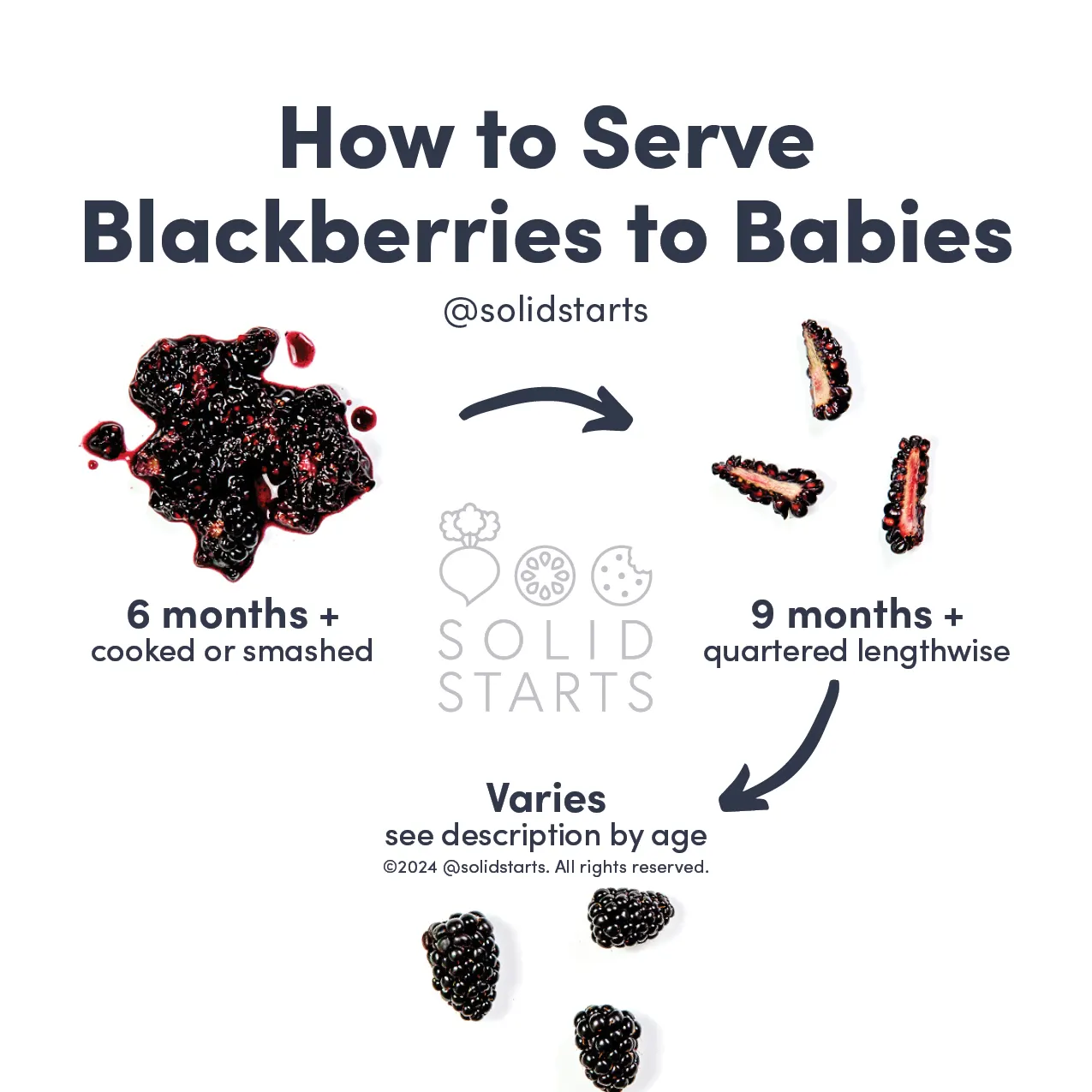Blackberry
Fruit
Age Suggestion
6 months
Iron-Rich
No
Common Allergen
No

When can babies have blackberries?
Blackberries may be introduced as soon as baby is ready to start solids, which is generally around 6 months of age.
Native to temperate climates, blackberries thrive on all continents except Antarctica and, along with the plant’s leaves, roots, and stems have served many purposes. Years of wild mixing and agricultural cultivation have spawned a diverse family tree: boysenberries, dewberries, loganberries, marionberries, newberries, and tayberries are all varieties of blackberries.
Are blackberries healthy for babies?
Yes. Blackberries offer plenty of fiber to promote gut health and lots of vitamin C, a nutrient that supports immunity and helps the body absorb iron. Blackberries also contain other potent antioxidants like anthocyanins, flavanols, and phenolic acids—plant compounds that help the body stay healthy. In fact, blackberries are one of the richest food sources of antioxidants.
Are blackberries a common allergen?
No. Reported cases of blackberry allergy are limited and blackberry allergies are generally uncommon. As you would when introducing any new food, offer a small quantity for the first few servings and watch closely as baby eats. If there is no adverse reaction, gradually increase the serving size over future meals.
Are blackberries a choking hazard for babies?
Yes. Blackberries can be small, round, and sometimes quite firm, qualities that increase the risk of choking. To reduce the risk, prepare and serve blackberries in an age-appropriate way. As always, make sure you create a safe eating environment and stay within an arm’s reach of baby during meals.
Learn the signs of choking and gagging and more about choking first aid in our free guides, Infant Rescue and Toddler Rescue.
How do you serve blackberries to babies?
Every baby develops on their own timeline, and the suggestions on how to cut or prepare particular foods are generalizations for a broad audience.
6 months old +:
Cook ripe, fresh or frozen blackberries until the berries burst or smash very ripe, soft berries between your thumb and pointer finger or the back of a fork, then mix the berries into soft, scoopable foods like grain porridge, ricotta cheese, or yogurt. Cooked blackberries (in muffins, pancakes, and other baked goods) can be left whole or chopped as desired, since they soften and burst with heat.
9 months old +:
Quarter ripe, soft blackberries lengthwise and offer as finger food to let baby practice their developing pincer grasp (where the thumb and pointer finger meet to pick up smaller pieces of food). When you feel ready, consider offering ripe, soft blackberries that have been cut in half lengthwise. If the child is shoveling handfuls of food in their mouth, serve the halved berries scattered directly on the tray or table (rather than in a bowl), which encourages the child to slow down and eat one piece of food at a time. You can also continue to mash or cook the berries into scoopable foods or serve cooked blackberries in bite-sized pieces of breads, muffins, etc.
12 months old +:
Around this age, many toddlers are ready to eat whole ripe blackberries. If you choose to offer whole berries, opt for the largest, softest ones you can find (about half the size of the toddler’s palm). Larger berries can actually present less of a choking risk than smaller ones, which can be similar in size to the toddler’s trachea. The smaller or firmer the berry, the higher the choking risk. Follow the child’s lead and continue quartering or halving berries as necessary or desired, as well.


How to choose and prepare blackberries for babies 6 months+
Written by
Expert Tips Delivered to Your Inbox
Sign up for weekly tips, recipes and more!
The content offered on SolidStarts.com is for informational purposes only. Solidstarts is not engaged in rendering professional advice, whether medical or otherwise, to individual users or their children or families. No content on this site, regardless of date, should ever be used as a substitute for direct medical advice from your doctor or your medical or health professional, nutritionist, or expert in pediatric feeding and eating. By accessing the content on SolidStarts.com, you acknowledge and agree that you are accepting the responsibility for your child’s health and well-being. In return for providing you with an array of content “baby-led weaning” information, you waive any claims that you or your child may have as a result of utilizing the content on SolidStarts.com.








